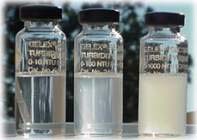Formazine
Formazine is a synthetic polymer used primarily in the calibration of turbidimeters, instruments that measure the turbidity or cloudiness of fluid samples. The substance is notable for its stability and reproducibility, making it a standard in the assessment of water quality in both environmental and laboratory settings. Formazine is synthesized through a reaction between hexamethylenetetramine (HMT) and hydrazine sulfate in an aqueous solution.
Synthesis[edit | edit source]
The synthesis of formazine begins with the mixing of hexamethylenetetramine and hydrazine sulfate in water. This reaction produces a colloidal suspension of formazine, which exhibits turbidity. The level of turbidity can be precisely controlled, making formazine solutions ideal for calibrating turbidimeters. These solutions are used to generate a calibration curve, against which the turbidity of unknown samples can be measured.
Applications[edit | edit source]
Formazine's primary application is in the calibration of turbidimeters, devices essential for the analysis of water quality. Turbidimeters measure the degree to which light is either absorbed or scattered by particles suspended in a liquid, a key indicator of the liquid's clarity or turbidity. Given the importance of accurate turbidity measurements in ensuring safe drinking water and monitoring environmental water bodies, formazine plays a critical role in environmental science and public health.
Safety and Handling[edit | edit source]
While formazine is invaluable in turbidity measurement, it requires careful handling due to the toxic nature of its precursor, hydrazine sulfate. Proper safety protocols, including the use of personal protective equipment (PPE) and adequate ventilation, are essential when synthesizing or handling formazine solutions.
Regulatory Standards[edit | edit source]
The use of formazine in turbidity measurement is supported by various regulatory standards worldwide. These standards ensure that water quality assessments are consistent, reliable, and adhere to public health guidelines. The Environmental Protection Agency (EPA) in the United States, for example, has established guidelines for turbidity measurement that include the use of formazine-based calibration.
Conclusion[edit | edit source]
Formazine's role in the calibration of turbidimeters underscores its importance in the field of water quality analysis. Its reliability and reproducibility make it a cornerstone in the measurement of turbidity, a critical parameter in environmental monitoring and public health.
Transform your life with W8MD's budget GLP1 injections from $125
W8MD offers a medical weight loss program NYC and a clinic to lose weight in Philadelphia. Our W8MD's physician supervised medical weight loss centers in NYC provides expert medical guidance, and offers telemedicine options for convenience.
Why choose W8MD?
- Comprehensive care with FDA-approved weight loss medications including:
- loss injections in NYC both generic and brand names:
- weight loss medications including Phentermine, Qsymia, Diethylpropion etc.
- Accept most insurances for visits or discounted self pay cost.
- Generic weight loss injections starting from just $125.00 for the starting dose
- In person weight loss NYC and telemedicine medical weight loss options in New York city available
- Budget GLP1 weight loss injections in NYC starting from $125.00 biweekly with insurance!
Book Your Appointment
Start your NYC weight loss journey today at our NYC medical weight loss, and Philadelphia medical weight loss Call (718)946-5500 for NY and 215 676 2334 for PA
Search WikiMD
Ad.Tired of being Overweight? Try W8MD's NYC physician weight loss.
Semaglutide (Ozempic / Wegovy and Tirzepatide (Mounjaro / Zepbound) available. Call 718 946 5500.
Advertise on WikiMD
|
WikiMD's Wellness Encyclopedia |
| Let Food Be Thy Medicine Medicine Thy Food - Hippocrates |
Translate this page: - East Asian
中文,
日本,
한국어,
South Asian
हिन्दी,
தமிழ்,
తెలుగు,
Urdu,
ಕನ್ನಡ,
Southeast Asian
Indonesian,
Vietnamese,
Thai,
မြန်မာဘာသာ,
বাংলা
European
español,
Deutsch,
français,
Greek,
português do Brasil,
polski,
română,
русский,
Nederlands,
norsk,
svenska,
suomi,
Italian
Middle Eastern & African
عربى,
Turkish,
Persian,
Hebrew,
Afrikaans,
isiZulu,
Kiswahili,
Other
Bulgarian,
Hungarian,
Czech,
Swedish,
മലയാളം,
मराठी,
ਪੰਜਾਬੀ,
ગુજરાતી,
Portuguese,
Ukrainian
Medical Disclaimer: WikiMD is not a substitute for professional medical advice. The information on WikiMD is provided as an information resource only, may be incorrect, outdated or misleading, and is not to be used or relied on for any diagnostic or treatment purposes. Please consult your health care provider before making any healthcare decisions or for guidance about a specific medical condition. WikiMD expressly disclaims responsibility, and shall have no liability, for any damages, loss, injury, or liability whatsoever suffered as a result of your reliance on the information contained in this site. By visiting this site you agree to the foregoing terms and conditions, which may from time to time be changed or supplemented by WikiMD. If you do not agree to the foregoing terms and conditions, you should not enter or use this site. See full disclaimer.
Credits:Most images are courtesy of Wikimedia commons, and templates, categories Wikipedia, licensed under CC BY SA or similar.
Contributors: Prab R. Tumpati, MD




